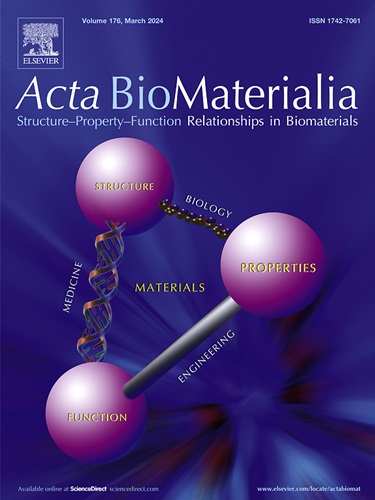Discoidal nanoparticles exploit thrombus-induced shear gradients to enhance site-specific thrombolysis in stroke
IF 9.6
1区 医学
Q1 ENGINEERING, BIOMEDICAL
引用次数: 0
Abstract
Thromboembolic stroke is characterized by cerebral ischemia caused by arterial thrombosis. Although tissue plasminogen activator (tPA) remains the gold standard for thrombolytic therapy, its clinical use is limited by a narrow therapeutic window and the need for continuous infusion. Nanoparticle-based delivery platforms have been explored to enhance the thrombolytic performance of tPA; however, efficient targeting to thrombus sites remains a key challenge. Notably, thrombosis-induced alterations in blood flow shear stress significantly influence the margination behavior of nanoparticles, which is highly dependent on their morphology and directly impacts thrombus accumulation and lytic efficacy. In this study, we fabricated poly (lactic-co-glycolic acid) (PLGA) nanoparticles with spherical, rod-shaped, and discoidal geometries, and conjugated them with tPA. Among these, discoidal nanoparticles (D-tPA) demonstrated enhanced margination and preferential adhesion to thrombi under high shear conditions, leading to improved thrombolysis and restoration of cerebral perfusion. These findings highlight the critical role of particle shape in vascular drug delivery and position discoidal PLGA nanoparticles as a promising strategy for targeted thrombolytic therapy in ischemic stroke.
Statement of significance
This study presents the application of discoidal poly (lactic-co-glycolic acid) (PLGA) nanoparticles for the treatment of thromboembolic stroke, offering an innovative approach to improving drug delivery and thrombolytic efficiency. Compared to spherical or rod-shaped nanoparticles, discoidal nanoparticles exhibit significant margination and thrombus adhesion under high shear stress conditions, thereby enhancing thrombolysis and promoting blood flow restoration. This work opens new avenues for nanomedicine in stroke therapy and holds potential clinical significance for more effective and targeted treatments in vascular diseases.

盘状纳米颗粒利用血栓诱导的剪切梯度增强脑卒中部位特异性溶栓。
血栓栓塞性中风的特点是由动脉血栓形成引起的脑缺血。尽管组织纤溶酶原激活剂(tPA)仍然是溶栓治疗的金标准,但其临床应用受到狭窄治疗窗口和需要持续输注的限制。研究人员探索了基于纳米颗粒的给药平台,以增强tPA的溶栓性能;然而,血栓部位的有效靶向仍然是一个关键的挑战。值得注意的是,血栓形成引起的血流剪切应力的改变显著影响纳米颗粒的边缘行为,这高度依赖于它们的形态,并直接影响血栓的积累和溶解效果。在这项研究中,我们制备了具有球形、棒状和盘状几何形状的聚乳酸-羟基乙酸(PLGA)纳米颗粒,并将它们与tPA偶联。其中,盘状纳米颗粒(D-tPA)在高剪切条件下表现出增强的边缘性和对血栓的优先粘附,从而改善血栓溶解和脑灌注恢复。这些发现强调了颗粒形状在血管药物输送中的关键作用,并将盘状PLGA纳米颗粒定位为缺血性卒中靶向溶栓治疗的有希望的策略。意义声明:本研究介绍了盘状聚乳酸-羟基乙酸纳米颗粒(PLGA)在血栓栓塞性卒中治疗中的应用,为改善药物输送和溶栓效率提供了一种创新方法。与球形或杆状纳米颗粒相比,盘状纳米颗粒在高剪切应力条件下表现出明显的边沿性和血栓粘附性,从而增强溶栓作用,促进血流恢复。这项工作为纳米医学在中风治疗中开辟了新的途径,并对血管疾病更有效和更有针对性的治疗具有潜在的临床意义。
本文章由计算机程序翻译,如有差异,请以英文原文为准。
求助全文
约1分钟内获得全文
求助全文
来源期刊

Acta Biomaterialia
工程技术-材料科学:生物材料
CiteScore
16.80
自引率
3.10%
发文量
776
审稿时长
30 days
期刊介绍:
Acta Biomaterialia is a monthly peer-reviewed scientific journal published by Elsevier. The journal was established in January 2005. The editor-in-chief is W.R. Wagner (University of Pittsburgh). The journal covers research in biomaterials science, including the interrelationship of biomaterial structure and function from macroscale to nanoscale. Topical coverage includes biomedical and biocompatible materials.
 求助内容:
求助内容: 应助结果提醒方式:
应助结果提醒方式:


